check engine MITSUBISHI SHOGUN 2016 (in English) User Guide
[x] Cancel search | Manufacturer: MITSUBISHI, Model Year: 2016, Model line: SHOGUN, Model: MITSUBISHI SHOGUN 2016Pages: 404, PDF Size: 18.95 MB
Page 153 of 404
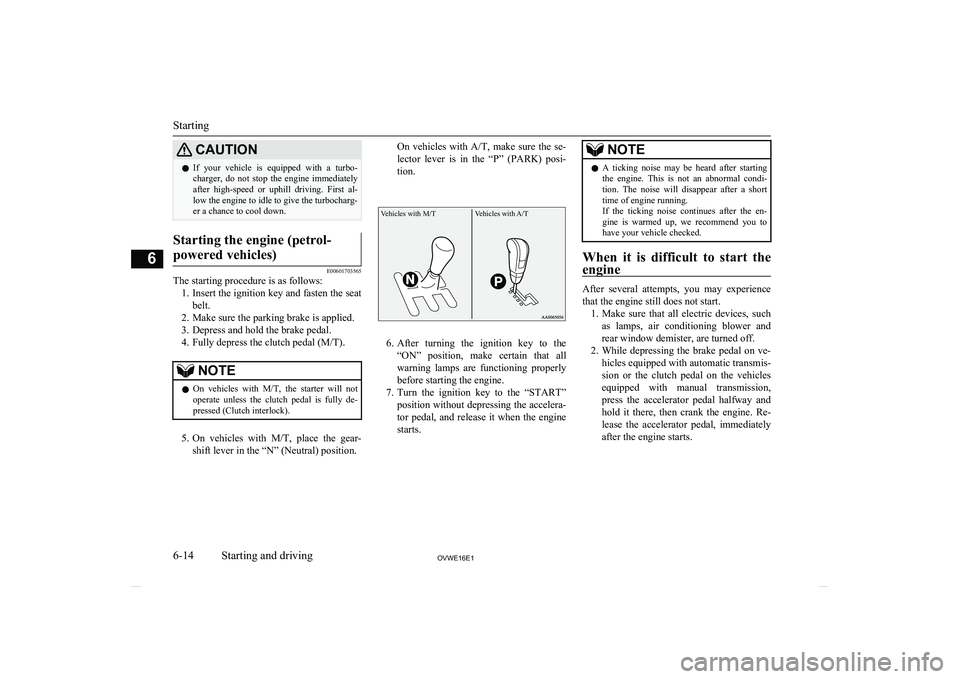
CAUTIONlIf your vehicle is equipped with a turbo-
charger, do not stop the engine immediately
after high-speed or uphill driving. First al-
low the engine to idle to give the turbocharg-
er a chance to cool down.Starting the engine (petrol-
powered vehicles)
E00601703565
The starting procedure is as follows: 1. Insert the ignition key and fasten the seat
belt.
2. Make sure the parking brake is applied.
3. Depress and hold the brake pedal.
4. Fully depress the clutch pedal (M/T).
NOTEl On vehicles with
M/T, the starter will not
operate unless the clutch pedal is fully de- pressed (Clutch interlock).
5. On vehicles with M/T, place the gear-
shift lever in the “N” (Neutral) position.
On vehicles with A/T, make sure the se-
lector lever is in the “P” (PARK) posi- tion.Vehicles with M/TVehicles with A/T
6. After turning the ignition key to the
“ON” position, make certain that all
warning lamps are functioning properly before starting the engine.
7. Turn the ignition key to the “START”
position without depressing the accelera-
tor pedal, and release it when the engine starts.
NOTEl A ticking noise may be heard after starting
the engine. This is not an abnormal condi-tion. The noise will disappear after a shorttime of engine running.
If the ticking noise continues after the en-
gine is warmed up, we recommend you to have your vehicle checked.
When it is difficult to start the
engine
After several attempts, you may experience that the engine still does not start. 1. Make sure that all electric devices, such
as lamps, air conditioning blower and
rear window demister, are turned off.
2. While depressing the brake pedal on ve-
hicles equipped with automatic transmis- sion or the clutch pedal on the vehiclesequipped with manual transmission,
press the accelerator pedal halfway and hold it there, then crank the engine. Re-
lease the accelerator pedal, immediately
after the engine starts.
Starting
6-14OVWE16E1Starting and driving6
Page 154 of 404
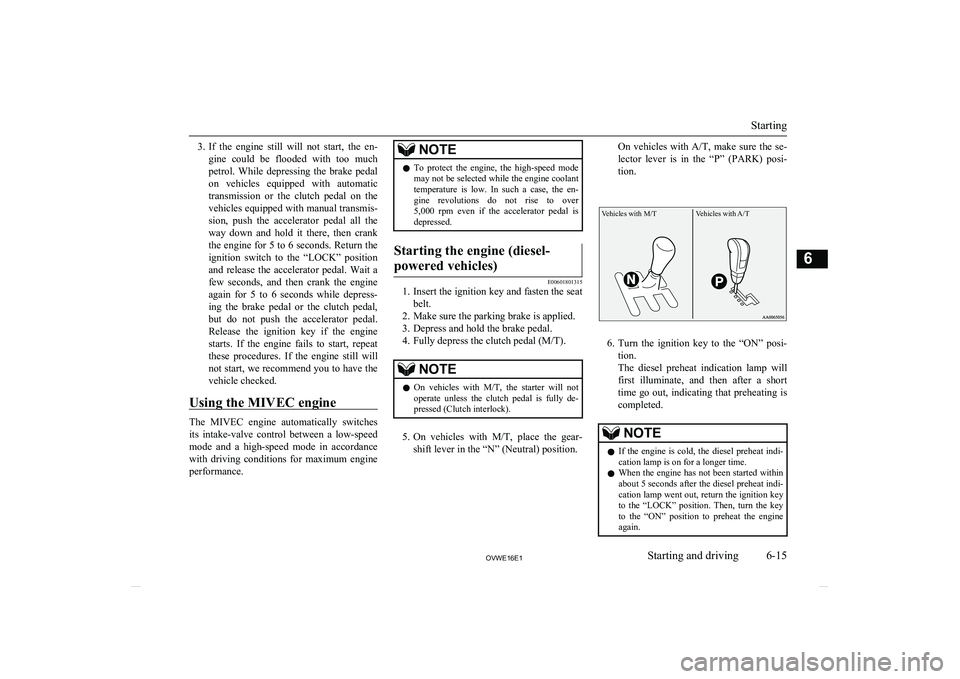
3.If the engine still will not start, the en-
gine could be flooded with too much petrol. While depressing the brake pedal
on vehicles equipped with automatic transmission or the clutch pedal on thevehicles equipped with manual transmis- sion, push the accelerator pedal all the
way down and hold it there, then crank the engine for 5 to 6 seconds. Return the
ignition switch to the “LOCK” position
and release the accelerator pedal. Wait a few seconds, and then crank the engine
again for 5 to 6 seconds while depress-
ing the brake pedal or the clutch pedal, but do not push the accelerator pedal.Release the ignition key if the engine
starts. If the engine fails to start, repeat these procedures. If the engine still willnot start, we recommend you to have the
vehicle checked.
Using the MIVEC engine
The MIVEC engine automatically switches its intake-valve control between a low-speed
mode and a high-speed mode in accordancewith driving conditions for maximum engine
performance.
NOTEl To protect the engine, the high-speed mode
may not be selected while the engine coolanttemperature is low. In such a case, the en-
gine revolutions do not rise to over
5,000 rpm even if the accelerator pedal is depressed.Starting the engine (diesel-
powered vehicles)
E00601801315
1. Insert the ignition key and fasten the seat
belt.
2. Make sure the parking brake is applied.
3. Depress and hold the brake pedal.
4. Fully depress the clutch pedal (M/T).
NOTEl On vehicles with
M/T, the starter will not
operate unless the clutch pedal is fully de- pressed (Clutch interlock).
5. On vehicles with M/T, place the gear-
shift lever in the “N” (Neutral) position.
On vehicles with A/T, make sure the se-
lector lever is in the “P” (PARK) posi- tion.Vehicles with M/TVehicles with A/T
6. Turn the ignition key to the “ON” posi-
tion.
The diesel preheat indication lamp will first illuminate, and then after a short
time go out, indicating that preheating is completed.
NOTEl If the engine is cold, the diesel preheat indi-
cation lamp is on for a longer time.
l When the engine has not been started within
about 5 seconds after the diesel preheat indi-
cation lamp went out, return the ignition key
to the “LOCK” position. Then, turn the key to the “ON” position to preheat the engine
again.
Starting
6-15OVWE16E1Starting and driving6
Page 164 of 404
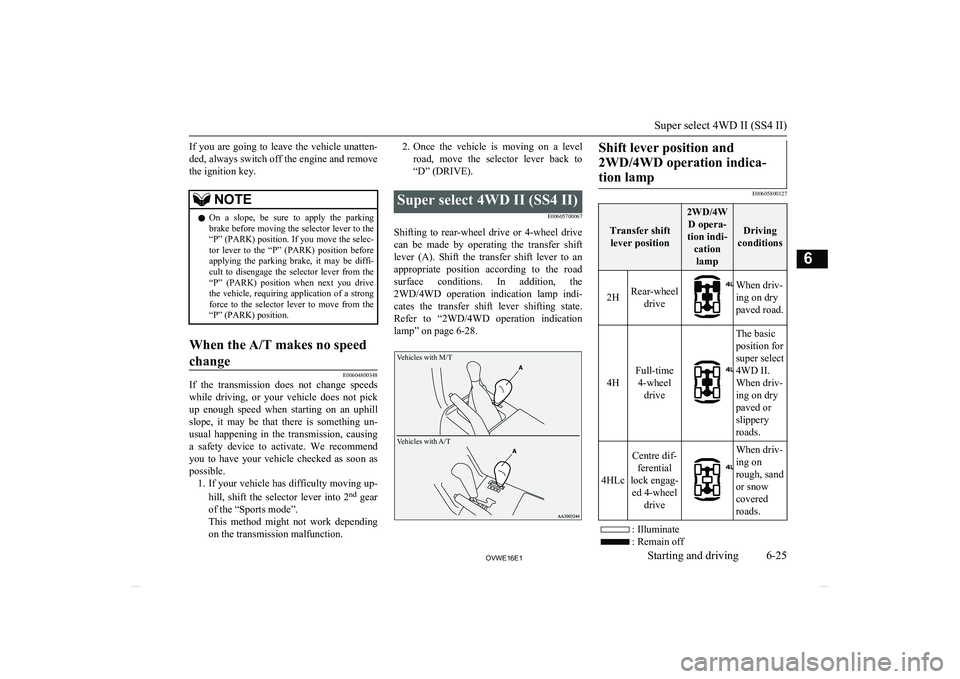
If you are going to leave the vehicle unatten-
ded, always switch off the engine and remove the ignition key.NOTEl On a slope, be sure to apply the parking
brake before moving the selector lever to the
“P” (PARK) position. If you move the selec- tor lever to the “P” (PARK) position before applying the parking brake, it may be diffi-
cult to disengage the selector lever from the
“P” (PARK) position when next you drive the vehicle, requiring application of a strong
force to the selector lever to move from the
“P” (PARK) position.When the A/T makes no speed
change
E00604800348
If the transmission does not change speeds
while driving, or your vehicle does not pick up enough speed when starting on an uphillslope, it may be that there is something un-
usual happening in the transmission, causing a safety device to activate. We recommendyou to have your vehicle checked as soon as
possible. 1. If your vehicle has difficulty moving up-
hill, shift the selector lever into 2nd
gear
of the “Sports mode”.
This method might not work depending
on the transmission malfunction.
2. Once the vehicle is moving on a level
road, move the selector lever back to
“D” (DRIVE).Super select 4WD II (SS4 II)
E00605700067
Shifting to rear-wheel drive or 4-wheel drive
can be made by operating the transfer shift lever (A). Shift the transfer shift lever to an appropriate position according to the roadsurface conditions. In addition, the
2WD/4WD operation indication lamp indi- cates the transfer shift lever shifting state.Refer to “2WD/4WD operation indicationlamp” on page 6-28.
Vehicles with M/TVehicles with A/TShift lever position and
2WD/4WD operation indica- tion lamp
E00605800127
Transfer shift lever position
2WD/4W D opera-
tion indi- cationlamp
Driving
conditions2HRear-wheel driveWhen driv-
ing on dry
paved road.
4H
Full-time 4-wheel drive
The basic
position for
super select
4WD II.
When driv-
ing on dry
paved or
slippery
roads.
4HLc
Centre dif- ferential
lock engag- ed 4-wheel driveWhen driv-
ing on
rough, sand
or snow
covered
roads.
: Illuminate
: Remain off
Super select 4WD II (SS4 II)
6-25OVWE16E1Starting and driving6
Page 169 of 404
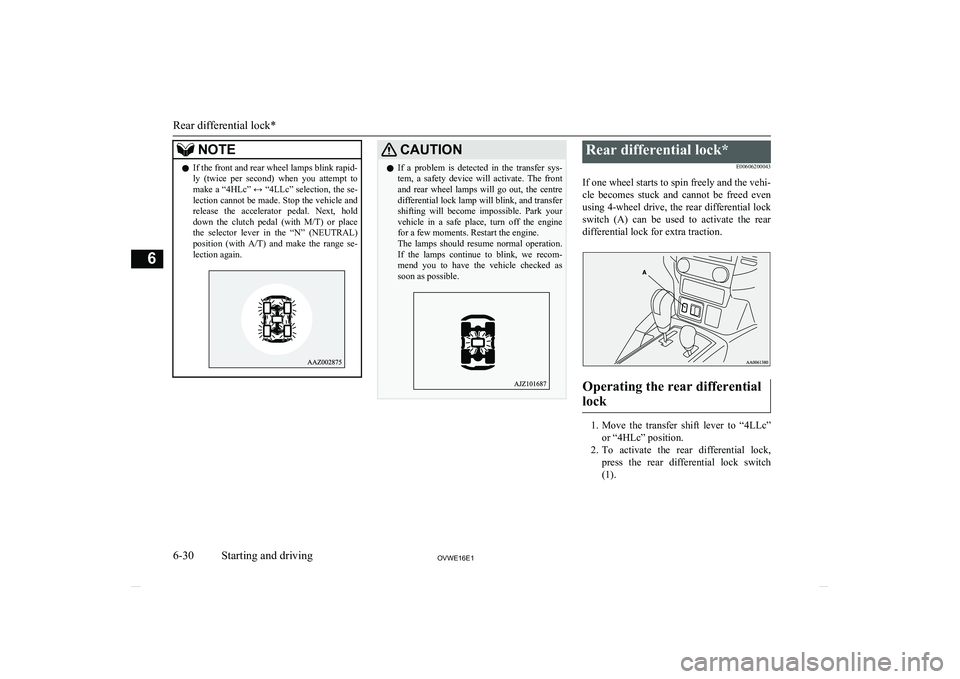
NOTElIf the front and rear wheel lamps blink rapid-
ly (twice per second) when you attempt to make a “4HLc” ↔ “4LLc” selection, the se- lection cannot be made. Stop the vehicle and
release the accelerator pedal. Next, hold
down the clutch pedal (with M/T) or place
the selector lever in the “N” (NEUTRAL)
position (with A/T) and make the range se-
lection again.CAUTIONl If a problem is detected in the transfer sys-
tem, a safety device will activate. The front and rear wheel lamps will go out, the centre
differential lock lamp will blink, and transfer shifting will become impossible. Park your vehicle in a safe place, turn off the engine
for a few moments. Restart the engine.
The lamps should resume normal operation. If the lamps continue to blink, we recom-
mend you to have the vehicle checked as soon as possible.Rear differential lock*
E00606200043
If one wheel starts to spin freely and the vehi-
cle becomes stuck and cannot be freed even using 4-wheel drive, the rear differential lock
switch (A) can be used to activate the rear differential lock for extra traction.
Operating the rear differential
lock
1. Move the transfer shift lever to “4LLc”
or “4HLc” position.
2. To activate the rear differential lock,
press the rear differential lock switch
(1).
Rear differential lock*
6-30OVWE16E1Starting and driving6
Page 171 of 404

The operation stateof rear differential lock2WD/4WD opera-
tion indication lampSwitching in pro- gressRear differential lockactivated
: Blink
: Illuminate (steady)
: Remain off
NOTElThe indication lamp blinks while the rear
differential lock is being switched between
its activated and deactivated conditions. When the switching operation is complete,
the indication lamp is either illuminated steadily or not illuminated.NOTEl The active stability & traction control
(ASTC) and anti-lock brake system (ABS)
functions are suspended while the rear dif- ferential lock is activated. ASTC indication
lamp, Active Stability Control function OFF indication lamp, ABS warning lamp and
brake warning lamp are illuminated while
these functions are suspended. It does not in- dicate a problem. When the rear differential lock is disengaged, these lamps go out and
function again.
Refer to “Brake warning lamp” on page
5-10 , “ABS warning lamp” on page 6-43,
“ASTC indication lamp” on page 6-45,
“Active stability control function OFF indi- cation lamp” on page 6-47.
l If the indication lamp continues blinking af-
ter the switch has been pressed to deactivate the rear differential lock, hold the steering
wheel in the straight ahead position then
slowly depress and release the accelerator pedal several times.
l If the indication lamp continues blinking af-
ter the switch has been pressed to activate the rear differential lock, bear in mind thefollowing instructions:
• If the vehicle speed is
12 km/h (7 mph) or
higher, decelerate to a speed of 6 km/h (4 mph) or lower. The switching opera-tion will be completed and the indication lamp will illuminate steadily.NOTE• If the vehicle speed is
12 km/h (7 mph) or
lower, turn the steering wheel from side to
side until the indication lamp illuminates
steadily. If the vehicle is stuck in soft ground, make sure the area around the ve- hicle is clear then repeatedly attempt to
drive forward and backward. The switch- ing operation will be completed and the
indication lamp will illuminate steadily.CAUTIONl If a problem is detected in the rear differen-
tial lock system, a safety device will acti- vate. The centre differential lock lamp, front and rear wheel lamps will go out, the reardifferential lock indication lamp will blink,
and the rear differential lock will deactivate.
Park your vehicle in a safe place, turn off the engine for a few moments. Restart the en-gine.
It is safe to continue driving if the lamps re- sume normal operation. If the rear differen-
tial lock indication lamp blinks when the rear differential lock is reactivated, we rec-
ommend you to have the vehicle checked as soon as possible.
Rear differential lock*
6-32OVWE16E1Starting and driving6
Page 174 of 404
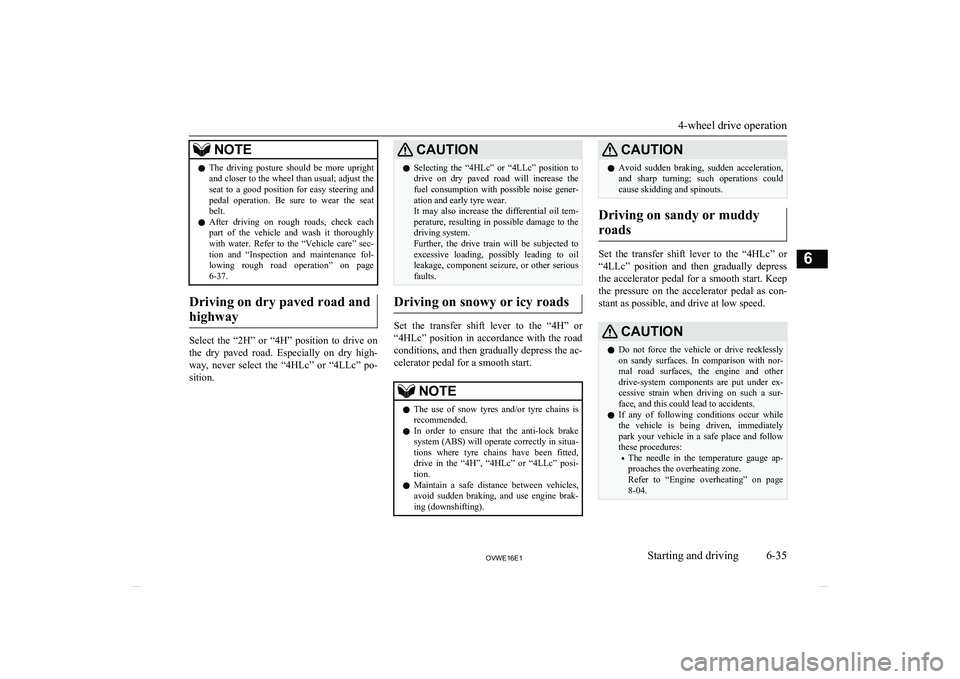
NOTElThe driving posture should be more upright
and closer to the wheel than usual; adjust the
seat to a good position for easy steering and pedal operation. Be sure to wear the seatbelt.
l After driving on rough roads, check each
part of the vehicle and wash it thoroughlywith water. Refer to the “Vehicle care” sec-
tion and “Inspection and maintenance fol-
lowing rough road operation” on page 6-37.
Driving on dry paved road and
highway
Select the “2H” or “4H” position to drive on
the dry paved road. Especially on dry high- way, never select the “4HLc” or “4LLc” po-sition.
CAUTIONl Selecting the “4HLc” or “4LLc” position to
drive on dry paved road will increase the
fuel consumption with possible noise gener- ation and early tyre wear.
It may also increase the differential oil tem-
perature, resulting in possible damage to the driving system.
Further, the drive train will be subjected to
excessive loading, possibly leading to oil leakage, component seizure, or other serious faults.
Driving on snowy or icy roads
Set the transfer shift lever to the “4H” or
“4HLc” position in accordance with the road conditions, and then gradually depress the ac-
celerator pedal for a smooth start.
NOTEl The use of snow tyres and/or tyre chains is
recommended.
l In order to ensure that the anti-lock brake
system (ABS) will operate correctly in situa-tions where tyre chains have been fitted, drive in the “4H”, “4HLc” or “4LLc” posi-tion.
l Maintain a safe distance between vehicles,
avoid sudden braking, and use engine brak- ing (downshifting).CAUTIONl Avoid sudden braking, sudden acceleration,
and sharp turning; such operations could
cause skidding and spinouts.
Driving on sandy or muddy
roads
Set the transfer shift lever to the “4HLc” or “4LLc” position and then gradually depress
the accelerator pedal for a smooth start. Keep
the pressure on the accelerator pedal as con- stant as possible, and drive at low speed.
CAUTIONl Do not force the vehicle or drive recklessly
on sandy surfaces. In comparison with nor-
mal road surfaces, the engine and other
drive-system components are put under ex- cessive strain when driving on such a sur-
face, and this could lead to accidents.
l If any of following conditions occur while
the vehicle is being driven, immediately park your vehicle in a safe place and follow these procedures:
• The needle in the temperature gauge ap-
proaches the overheating zone.
Refer to “Engine overheating” on page
8-04.
4-wheel drive operation
6-35OVWE16E1Starting and driving6
Page 175 of 404

CAUTION•A/T fluid temperature warning lamp illu-
minates.
Refer to “When the A/T fluid temperature
warning lamp comes on” on page 6-23.WARNINGl When attempting to rock your vehicle out
of a stuck position, be sure that the area
around the vehicle is clear of people and physical objects. The rocking motion may
cause the vehicle to suddenly launch for- ward or backward, causing injury or damage to nearby people or objects.NOTEl Avoid sudden braking, acceleration, and
turning; such operations could result in thevehicle becoming stuck.
l If the vehicle becomes stuck in sandy or
muddy roads, it can often be moved with a
rocking motion. Move the selector lever rhythmically between the “D” (DRIVE) and
“R” (REVERSE) position (with M/T, be-
tween 1 st
and Reverse), while applying
slight pressure to the accelerator pedal.
l It is recommended to start the vehicle with
parking brake partially, but not completely, applied by slightly pulling the parking brake lever.
After the vehicle has become free, do not forget to release the parking brake.NOTEl If it is necessary to drive in extremely mud-
dy conditions, the use of tyre chains is rec-
ommended. Because the extent of muddy conditions is difficult to judge and the vehi- cle could become bogged down very deeply,
operation should be at a low speed. If possi-
ble, get out of the vehicle and check the con-
ditions ahead before proceeding.
l Driving over roads in coastal areas or roads
on which anti-skid preparations have been
spread can cause rust on the vehicle; wash
the vehicle thoroughly as soon as possible after such use.
Climbing sharp grades
Set the transfer shift lever to the “4LLc” po-
sition to maximize the engine torque.
WARNINGl Go straight up. Do not try to traverse
across a steep slope.
l If you begin to lose traction, ease off the
accelerator pedal and gently turn the steering wheel alternatively left and right
to regain adequate traction again.NOTEl Choose as smooth a slope as possible with
few stones or other obstacles.NOTEl Before attempting to drive up the slope,
walk it up to confirm that the vehicle canhandle the grade.
Descending sharp grades
Set the transfer shift lever to the “4LLc” po-
sition, use the engine brake (downshifting)
and descend slowly.
WARNINGl Avoid snaking down a sharp grade. De-
scend the grade as straight as possible.NOTEl When descending a sharp grade, if the
brakes are applied suddenly because of an
obstacle encountered, control of the vehicle
could be lost. Before descending the slope,
walk it down and confirm the path.
l Before descending a grade, it is necessary to
choose the appropriate gear. Avoid changing
gears or depressing the clutch while de- scending the grade.
4-wheel drive operation
6-36OVWE16E1Starting and driving6
Page 177 of 404
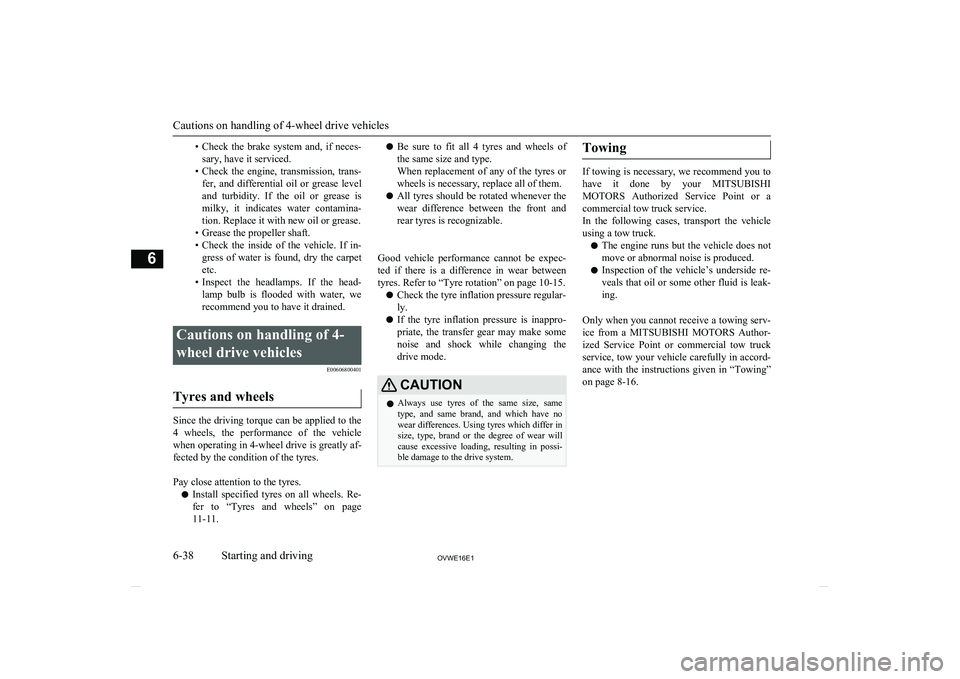
•Check the brake system and, if neces-
sary, have it serviced.
• Check the engine, transmission, trans-
fer, and differential oil or grease level and turbidity. If the oil or grease is
milky, it indicates water contamina-
tion. Replace it with new oil or grease.
• Grease the propeller shaft.
• Check the inside of the vehicle. If in-
gress of water is found, dry the carpet
etc.
• Inspect the headlamps. If the head-
lamp bulb is flooded with water, we
recommend you to have it drained.Cautions on handling of 4-
wheel drive vehicles E00606800401
Tyres and wheels
Since the driving torque can be applied to the
4 wheels, the performance of the vehicle when operating in 4-wheel drive is greatly af- fected by the condition of the tyres.
Pay close attention to the tyres.
l Install specified tyres on all wheels. Re-
fer to “Tyres and wheels” on page
11-11.
l Be sure to fit all 4 tyres and wheels of
the same size and type.
When replacement of any of the tyres or
wheels is necessary, replace all of them.
l All tyres should be rotated whenever the
wear difference between the front and
rear tyres is recognizable.
Good vehicle performance cannot be expec- ted if there is a difference in wear between
tyres. Refer to “Tyre rotation” on page 10-15.
l Check the tyre inflation pressure regular-
ly.
l If the tyre inflation pressure is inappro-
priate, the transfer gear may make some
noise and shock while changing the drive mode.CAUTIONl Always use tyres of the same size, same
type, and same brand, and which have no wear differences. Using tyres which differ in
size, type, brand or the degree of wear will
cause excessive loading, resulting in possi- ble damage to the drive system.Towing
If towing is necessary, we recommend you to
have it done by your MITSUBISHI
MOTORS Authorized Service Point or a
commercial tow truck service.
In the following cases, transport the vehicle
using a tow truck.
l The engine runs but the vehicle does not
move or abnormal noise is produced.
l Inspection of the vehicle’s underside re-
veals that oil or some other fluid is leak- ing.
Only when you cannot receive a towing serv- ice from a MITSUBISHI MOTORS Author-
ized Service Point or commercial tow truck
service, tow your vehicle carefully in accord- ance with the instructions given in “Towing”
on page 8-16.Cautions on handling of 4-wheel drive vehicles
6-38OVWE16E1Starting and driving6
Page 178 of 404
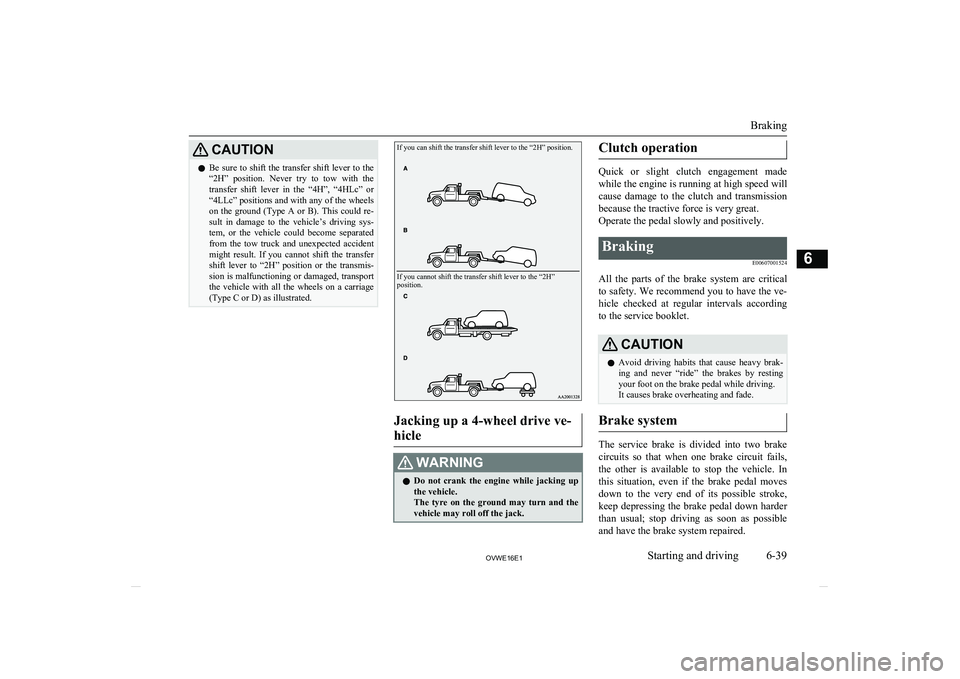
CAUTIONlBe sure to shift the transfer shift lever to the
“2H” position. Never try to tow with the transfer shift lever in the “4H”, “4HLc” or
“4LLc” positions and with any of the wheels
on the ground (Type A or B). This could re- sult in damage to the vehicle’s driving sys- tem, or the vehicle could become separated from the tow truck and unexpected accident
might result. If you cannot shift the transfer shift lever to “2H” position or the transmis-
sion is malfunctioning or damaged, transport the vehicle with all the wheels on a carriage (Type C or D) as illustrated.If you can shift the transfer shift lever to the “2H” position.If you cannot shift the transfer shift lever to the “2H”
position.
Jacking up a 4-wheel drive ve-
hicle
WARNINGl Do not crank the engine while jacking up
the vehicle.
The tyre on the ground may turn and the
vehicle may roll off the jack.Clutch operation
Quick or slight clutch engagement made
while the engine is running at high speed will
cause damage to the clutch and transmission because the tractive force is very great.
Operate the pedal slowly and positively.
Braking
E00607001524
All the parts of the brake system are critical
to safety. We recommend you to have the ve- hicle checked at regular intervals according
to the service booklet.
CAUTIONl Avoid driving habits that cause heavy brak-
ing and never “ride” the brakes by resting
your foot on the brake pedal while driving.
It causes brake overheating and fade.
Brake system
The service brake is divided into two brake
circuits so that when one brake circuit fails, the other is available to stop the vehicle. In
this situation, even if the brake pedal moves down to the very end of its possible stroke,
keep depressing the brake pedal down harder than usual; stop driving as soon as possible
and have the brake system repaired.
Braking
6-39OVWE16E1Starting and driving6
Page 179 of 404
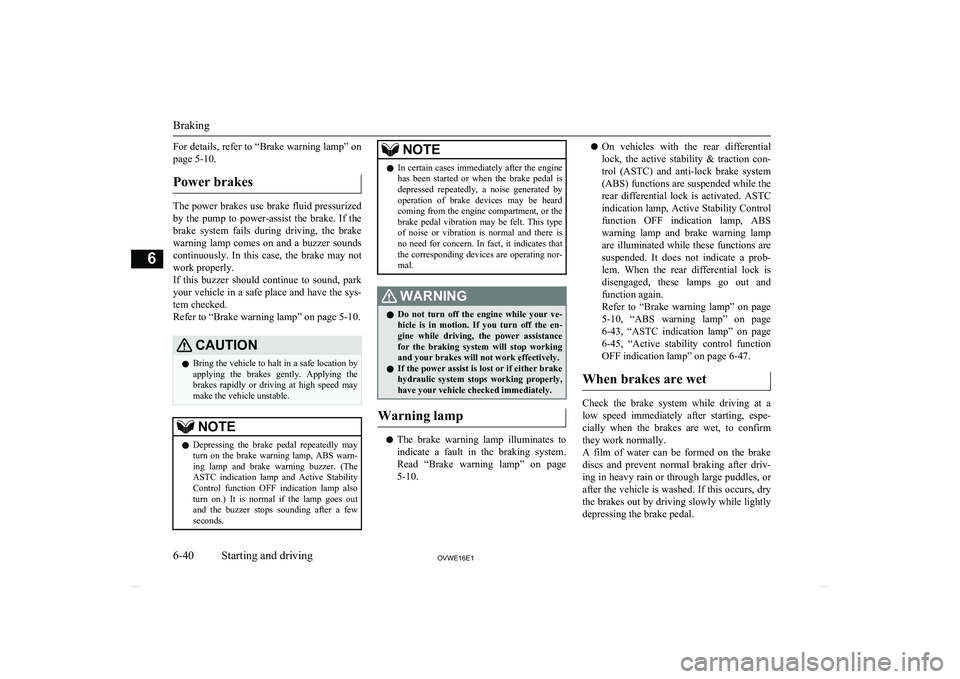
For details, refer to “Brake warning lamp” on
page 5-10.
Power brakes
The power brakes use brake fluid pressurized by the pump to power-assist the brake. If the brake system fails during driving, the brake
warning lamp comes on and a buzzer sounds continuously. In this case, the brake may not
work properly.
If this buzzer should continue to sound, park your vehicle in a safe place and have the sys-tem checked.
Refer to “Brake warning lamp” on page 5-10.
CAUTIONl Bring the vehicle to halt in a safe location by
applying the brakes gently. Applying the
brakes rapidly or driving at high speed may
make the vehicle unstable.NOTEl Depressing the brake pedal repeatedly may
turn on the brake warning lamp, ABS warn-ing lamp and brake warning buzzer. (The
ASTC indication lamp and Active Stability
Control function OFF indication lamp also
turn on.) It is normal if the lamp goes out and the buzzer stops sounding after a few
seconds.NOTEl In certain cases immediately after the engine
has been started or when the brake pedal is
depressed repeatedly, a noise generated by operation of brake devices may be heard coming from the engine compartment, or the
brake pedal vibration may be felt. This type
of noise or vibration is normal and there is
no need for concern. In fact, it indicates that
the corresponding devices are operating nor-
mal.WARNINGl Do not turn off the engine while your ve-
hicle is in motion. If you turn off the en-
gine while driving, the power assistance
for the braking system will stop working and your brakes will not work effectively.
l If the power assist is lost or if either brake
hydraulic system stops working properly,
have your vehicle checked immediately.
Warning lamp
l The brake warning lamp illuminates to
indicate a fault in the braking system.
Read “Brake warning lamp” on page
5-10.
l On vehicles with the rear differential
lock, the active stability & traction con-
trol (ASTC) and anti-lock brake system (ABS) functions are suspended while the
rear differential lock is activated. ASTC
indication lamp, Active Stability Control function OFF indication lamp, ABS warning lamp and brake warning lamp are illuminated while these functions are
suspended. It does not indicate a prob- lem. When the rear differential lock is
disengaged, these lamps go out and
function again.
Refer to “Brake warning lamp” on page
5-10 , “ABS warning lamp” on page
6-43 , “ASTC indication lamp” on page
6-45 , “Active stability control function
OFF indication lamp” on page 6-47.
When brakes are wet
Check the brake system while driving at a
low speed immediately after starting, espe- cially when the brakes are wet, to confirmthey work normally.
A film of water can be formed on the brake
discs and prevent normal braking after driv-
ing in heavy rain or through large puddles, or after the vehicle is washed. If this occurs, dry
the brakes out by driving slowly while lightly depressing the brake pedal.
Braking
6-40OVWE16E1Starting and driving6